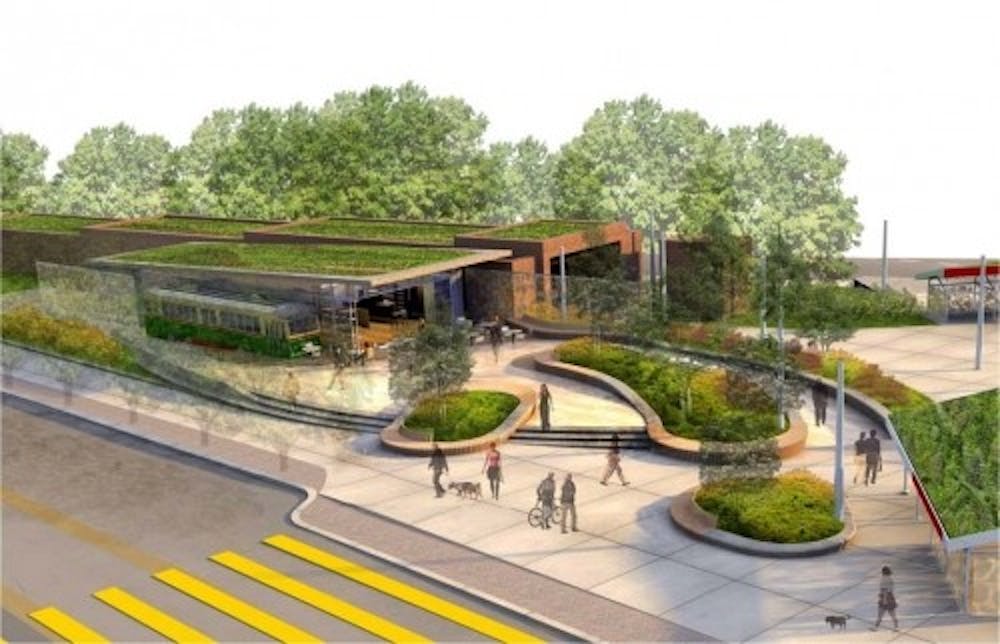
With a recent award of $6,500 from PECO and Natural Lands Trust, University City District is slowly coming closer to redeveloping the 40th Street trolley station.
UCD has been officially fundraising for the project since 2012, although it has been in the making for over a decade. As of now, UCD has raised $1.4 million of its $2 million goal — a $1 million decrease from the original $3 million estimated for the station’s renovation.
“Complicated public space projects take time and effort, and we’re ecstatic with the way this is coming together, but there is a lot more work to be done,” UCD spokesperson Lori Brennan said.
Though the plan to transform the 40th Street trolley portal into an attractive, greened plaza was announced only a couple years back, community leaders recognized the portal’s potential to become a neighborhood asset several years ago.
“There have been primary promoters of the project going back 10 years,” Barry Grossbach, director of the Spruce Hill District zoning committee, said. “But the project was shelved for a while ... since you can’t get anywhere unless you have an entity committed to raising funds and grants.”
Awarded with a William Penn Foundation planning grant in 2012, UCD finally took on the role as the key entity needed to revive the community’s ambitions for the trolley station. UCD — in collaboration with SEPTA, city agencies and landscape architects at Andropogon Associates — decided to spearhead the project largely due to its advantageous location.
At the junction of Baltimore Avenue, 40th Street and Woodland Avenue, the station has the 11, 13, 34 and 36 trolley lines running through it. Since the four trolley lines extend to all corners of West Philadelphia, the stop functions as a significant entryway into University City’s educational, medical and business opportunities.
“The portal is at the crossroads of economy-shaping institutions and job-creating commercial corridors and is a key access point that allows residents of the region to efficiently commute to Philadelphia’s central business district,” Brennan said.
UCD wants the space to better reflect the dynamic neighborhood that the station introduces. Traveling from Center City into West Philadelphia, SEPTA trolley riders currently emerge from a dark tunnel to face a bleak acre of underused space. But after the renovations, this unattractive first impression will become a “vibrant and social space, featuring trees, movable tables and chairs, native horticulture, artful lighting and boulders for creative play,” Brennan said.
Beyond drawing more SEPTA users, the plaza will also attract people since UCD hopes to add a local cafe and encourage social activities in the area. In the long-term plan, the site will introduce bike parking and eventually be “activated by a variety of arts and cultural programming, ranging from musical performances to temporary art installations,” Brennan said.
While the recent $6,500 grant leaves UCD close to its fundraising goal, the plan still needs to overcome some logistical issues. Since hundreds of trolleys pass through the station each day, SEPTA warns that the conceptual layout must account for “safety and operational concerns,” SEPTA spokesperson Jerria Williams said.
“Once UCD incorporates our comments, it’s really all a win-win situation since this project will bring more riders to our service and bring more community amenities to the people,” Williams added.
UCD will have an exact timeline and more details for the project later this fall.
The Daily Pennsylvanian is an independent, student-run newspaper. Please consider making a donation to support the coverage that shapes the University. Your generosity ensures a future of strong journalism at Penn.
DonatePlease note All comments are eligible for publication in The Daily Pennsylvanian.





